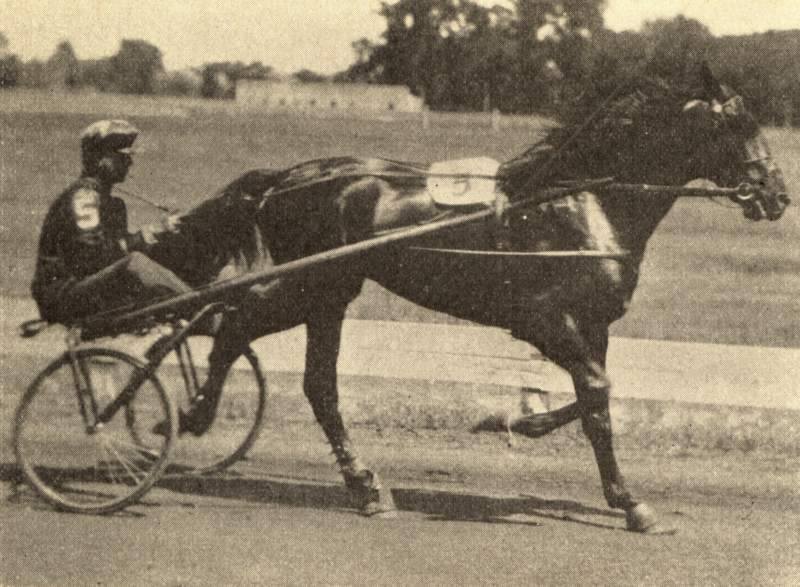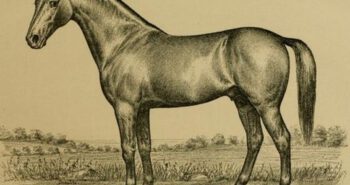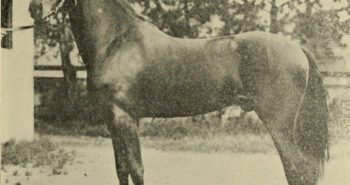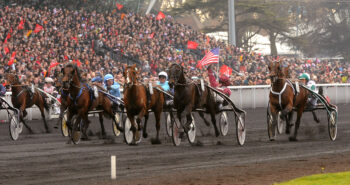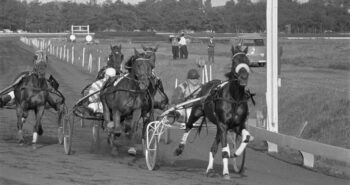The New England-star was sold to Europe and impressed the French so much he was purchased by their national stud. Despite all the high hopes, though, Net Worth turned out to be highly average as a stallion. There was nothing average about his performances on the track, however, as illustrated by him humiliating the French elite at Vincennes when he was 11.
Bred at Walnut Hall Farm, Net Worth was bought by William Bartlett from Milbury outside of Worchester, MA. The horse was ready early and won in 2:16 (1.24,5) as a two-year-old over a half-mile track. At three Net Worth didn’t go up against the best such as Walter Dear or Volomite, but did very well in conditioned races, both against three-year-old and aged opposition, winning five times and lowering his record to 2:10 1/4 (1.21,0). After wintering at home in Worchester after the 1929 season, Net Worth was further improved. The colt did not race at the big and fast racetracks in 1930 and thus missed out on a really fast record. He was nonetheless a star on New England tracks.
Almost unbeatable
After a good start to the 1930 season, including a third place against tough competition at Springfield, MA. Back home in Worchester, Net Worth won the 2:15 trot after placing 3-1-1 in the three heats. Going up to Keene, NH, the four-year-old colt was entered in the mixed event, pitting him against Lone Boy p2:07 1/4 (1.19,1) and other fast pacers. Despite this, Net Worth and Bartlett won all three heats. Going down to Cambridge, Net Worth again won all three heats, this time against trotters, winning in 2:10, 2:10, 2:10 3/4 (1.20,8, 1.20.8 and 1.21,3). Steamrolling the opposition, Net Worth again swept the opposition in three straight heats at Rutland, VT, winning in 2:10, 2:10 and 2:13 (1.20,8, 1.20,8 and 1.22,7) over a heavy and slow track. At Brockton, MA, he placed 1-2-1, winning the last heat in 2:07 (1.18,9), which turned out to be his personal best.
In an article in the Horse Review in December 1930, it said “If ever a horse gave a good account of himself, Net Worth did at Brockton, Mass., in the 2:15 trot, made more enjoyable to his owner because Brockton is not far from home. In the field were May Nelson, 4, 2:07 1/2 (1.19,2), Dr. Voorhis 2:10 1/4 (1.21,0), etc. He romped home first in the opening heat in 2:08 1/4 (1.19,7), came back a second one in 2:10 1/4 (1.21,0), and in the third with no effort to go faster, Brusie won the heat in 2:07 (1.18,9) with him, which is just a second away from Guy Fletcher’s record third heat in 2:06 (1.18,3), this year at Essex Junction, VT. Mr. Bartlett’s grand colt closed his account for 1930 with a sharp victory in the 2:15 trot at Worcester, Mass., for a $1,000 purse, racing consistently to the end of the season. In fact, never has he trotted a poor race, the source of the high regard in which he is held throughout New England.”
With that kind of reputation others were bound to be interested, and sure enough, in February 1931 it was reported in multiple newspapers that “two of the leading stars of the past season in Guy Fletcher 2:01 (1.15,2) and Net Worth 2:07 (1.18,9), a pair of young and well-bred stallions of rare racing capacity, whose sale to go across the big pond, will cause much regret among most trotting enthusiasts, in view of the losses sustained by the American standardbred industry at large. It is understood that the widely-known European trainer, Alexander Finn of Milan, Italy, obtained both trotters for Italian clients (…)”, the price of Net Worth reportedly $5,000. The buyer turned out to be wealthy Italian Daniele Palazzoli of Milan who had bought Hazleton a little earlier.
Impressing at 11
Net Worth was a very good horse both in Italy and France. He was equally comfortable both with and without a sulky. Net Worth mostly played second- or third-fiddle in Italy, struggling to beat Guy Flecter, Hazleton and Plucky, and later also Muscletone. In fact, he did better in France, winning the Prix de Belgique and Prix d’Angleterre in 1932. In the latter he beat Plucky as well as the French trotting queen Amazone B.
The following year he won the Prix de Copenhague and took third-place finishes in both Prix d’Amerique and the Prix d’Italie. Additionally he was second in the Prix de Cornulier. In 1934, Net Worth was fourth in the Prix d’Amerique. In 1936 he finished second in the Prix de Copenhague. Net Worth’s crowning, though, would come in 1937, at 11, as he won the Prix de Cornulier, the biggest monte/RUS race in the world. It wasn’t a complete surprise: in 1933, Net Worth had set a European monte record.
Failing to live up to expectations
Winning the biggest monte race in the world, though, is one thing. Winning it at age 11 is another. It’s impressive. But winning the biggest monte race in the world, at age 11, by six whole seconds in actual time over the 2600 meters (1 5/8 mile) is bordering on the insane. Net Worth won dominantly in 1.26,5 (2:19.2), while Impavide and Hernani III in the two next places trotted in 1.28,8 and 1.29.1 (2:23 and 2.23.2). Even the French were impressed, so much they actually bought the colt. The French stud-book was closed that year, but a special decree allowed Net Worth to stand stud from 1937 to 1946 at the National Stud and the colt was soon after the race bought by the French state. As the journalist in the French daily Le Figaro wrote “As remarkable under the saddle as in a harness, and of an irreproachable model, the son of MacGregor the Great represents for the future of our breed the most precious addition.”
As it turned out, the journalist was spot-on at the beginning, but terrible wrong at the end. Net Worth produced only one really good trotter, Simoun M, winner of the 1943 Criterium des 3 ans. He was a much better broodsire, such as Luth Grandchamp, winner of the 1958 Criterium des 3 ans, Bleinheim, winner of the 1949 Criterium des 4 ans, Olten L, winner of the 1963 Criterium des 5 ans. Today Net Worth is found in most French pedigrees as he is the damdamsire of And Arifant, the Italian-French cross who is the sire of star filly Mara Bourbon and sires such as Goetmals Wood, Fortuna Fant and Kaiser Soze – not to forget the damsire of Timoko, Love You and Billie de Montfort. A useful stallion, but not “the most precious addition” that French trotting was hoping for.
net worth
Brown colt born in Lexington, KY in 1926. Died in France in 1946.
MacGregor the Great – Hester Worthy (Guy Axworthy)
4, 2:07 (1.18,9)
Breeder: Walnut Hall Farm
Owners: Walnut Hall Farm – William Bartlett – Daniele Palazzoli – Haras Nationaux
Trainers: William Bartlett and Alexander Finn
Drivers: William Bartlett, Alexander Finn, Otto Dieffenbacher and others
Groom: –

